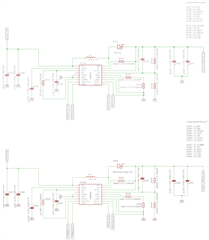Hello,
I'm working on a 4 Channel LED Board where two of the LM3492 are beeing used.
First driver is connected two the first two strings of LED and the second driver is connected
to the third and fourth sting of LED.
The board sholud be used within 24 VDC to 18 VDC and each string consits of 15 LEDs where the
string voltage is between 31,5VDC and 46.8VDC depending on the type of used LEDs in the string.
The current for the LEDs should be 50mA.

We produced several boards for testing now and we have the effect that the current is traveling
over 1A at 24VDC and at least one of the LM3492 will get very hot. But it will be different thru the
several boards, sometimes it's just one driver in some cases both of them going to be hot.
It seems that there is something wrong on the bottom line which we will not find by ourself.
Can you please double check the Scheme and give an advise?
Thanks in forward.


